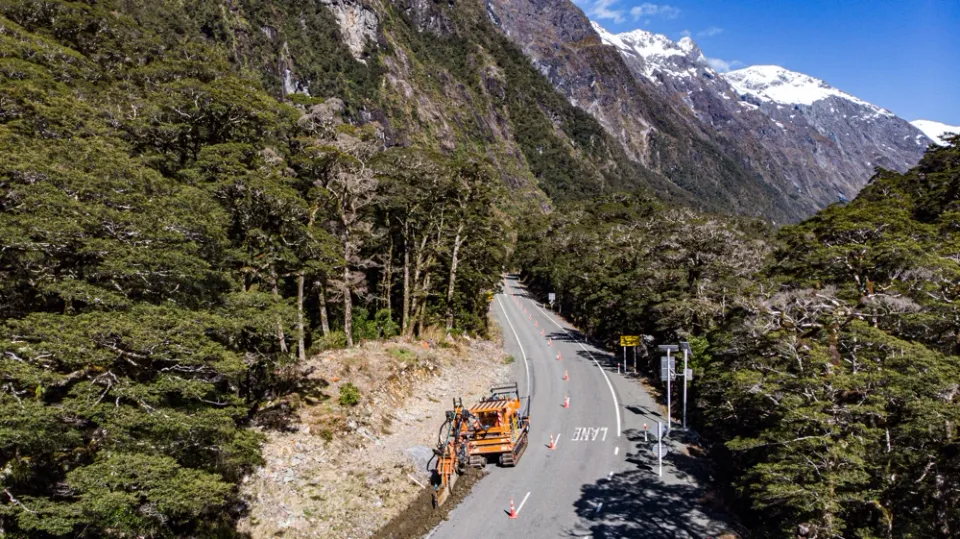Extreme weather trims Chorus result

Extreme weather trims Chorus result
Chorus reported a 60 per cent drop in full-year net profit at $25 million down from $64 million a year ago.
Part of that can be attributed to $10 million on one-off costs that hit the company following the extreme weather earlier this year. Yet there was an underlying decline thanks to increased interest payments, depreciation and amortisation expenses.
Revenue nudged up 1.5 per cent to $981 million, well behind the rate of inflation which sits at around 6 per cent. Chorus says the extra income came from a small increase in fibre connections, greater uptake of high-speed fibre plans and the inflation-linked annual price increase.
The company’s operating expenses remain flat at $299 million. This means an underlying Ebitda, when the cyclone costs are removed, of $682 million, up $22 million from 2022’s $660 million EBITDA.
Chorus managed to lift its full year dividend to 42.5 cents per share. That’s up from 35 cents a year ago. It forecasts a 47.5 cent payout in 2024.
Fibre market remains buoyant
Chorus reports the uptake of fibre in areas its services has now reached 73 per cent. During the year it added a further 72,000 fibre customers, the total is now a shade over one million. The company says 91 per cent of fibre plans are 300 Mbps or better.
Data use continues to rise. Chorus reports the average user chewed through 595 GB of data in a month. This is near where it peaked during the September 2021 pandemic lockdown.
Chorus says 45 per cent of all traffic on Chorus’ network is streaming video. This is where the CEO, JB Rousselot sees an opportunity. He says there is pent-up demand for 4K video. Yet, for now, there is less 4K video material available in New Zealand than in other markets. As that changes he expects to see an impact in terms of network traffic.
Greater competition
While Chorus and the UFB network have outperformed initial expectations by a wide margin, the figures show competition is biting.
You couldn’t argue that fixed wireless broadband is eating Chorus’ lunch, fibre is by far the more popular technology where it is available. Yet fixed wireless nibbles at the edges of what would otherwise be the near-monopoly that some early Chorus investors thought they were signing up for.
All three mobile networks offer fixed wireless broadband and sell it aggressively.
Spark alone added 15,000 fixed wireless customers in the last year. Both 2degrees and One NZ would have added thousands during the year. Not all of these would have been able to connect to fibre, but the challenge is significant.
The Commerce Commission’s Measuring Broadband New Zealand shows fixed wireless broadband offers far less capacity than fibre and is less reliable, yet for many consumers it can deliver all the internet they need. More 4K television sets in more lounges and bedrooms would help Chorus claw back a number of fixed wireless users.

Chorus adds Milford Sound to fibre footprint
Chorus has completed a 118 km fibre backhaul link between Te Anau and Milford Sound. The link is part of the wider upgrade of fibre on the West Coast of the South Island adding resiliency to the region’s communications.
Finance for the project came from the Provincial Growth Fund. Chorus worked with Crown Infrastructure Partners and Ventia to build the fibre.
Another key partner is the Rural Connectivity Group. The RCG uses the fibre as backhaul for eight mobile towers. These give coverage to drivers on State Highway 94. It’s a busy route. Up to a million drivers use it each year, yet it is one of the most remote and difficult major roads in the country.
Chorus CEO JB Rousselot says: “The fibre we’ve built will provide connectivity for eight new RCG mobile towers, including one in Milford Sound. People will primarily use this fibre backhaul through significantly improved mobile coverage, with fibre taking the traffic back to the mobile operator’s network.”
Solid result points to Spark's fibre era challenges
Selling a majority stake in its cell tower network saw Spark book a profit of $1.1 billion for the 2023 financial year. Revenue was up almost 21 per cent at $4,491 million while Ebitda hit $1,722 million.
Two negatives haunt Spark’s performance. Closing Spark Sport cost the company $54 million. This was part of the strategy to reposition the former telecom monopoly as a digital services provider.
Perhaps more concerning is the 2.2 per cent drop in revenue from Spark’s cloud computing, IT security and IT services management business.
This is now down to $436m at a time when the overseas owned hyper scale cloud vendors are ramping up their New Zealand presence.
Mix shift
Spark explains its cloud performance as a “mix shift from private cloud to public cloud and service management activity normalising post Covid 19”.
Thanks to the tower sales, this has been a year of significant one-offs. Strip that out of the numbers and Spark still managed to earn a 3.7 per cent increase in operating profit to a shade under $1.2 billion. While the company’s adjusted net profit came in at 5.6 per cent increase at $433 million.
With inflation running at around 6 per cent, this represents, at best, flat performance. However, the result was in line with earlier guidance from the company.
Spark chair Justine Smyth notes highlights included delivering: “market leadership in mobile, a stabilised leadership position in broadband, and strong growth in high-tech categories such as ‘internet of things’ and digital health."
Chief executive Jolie Hodson say the company has a clear plan for the next three years. It has the ability to invest to develop new revenue streams and had allocated between $250 and $300 million for investments in the “high growth data centre market”.
CCL charts barriers as cloud moves centre stage
Research from Spark’s CCL cloud division found almost nine in ten New Zealand organisations see cloud as important to their strategy.
The survey found 88 per cent rated cloud either as extremely or moderately important.
Despite recognising the importance of cloud, there are reasons organisations are not moving faster to adopt the technology. CCL says 31 per cent say that’s down to a lack of resources and expertise.
Almost as many (30 per cent) say they are concerned about costs and 27 per cent worry about the migration process. Roughly a quarter of organisations surveyed, (24 per cent) see incompatibility with existing technologies as a barrier.
One-offs behind falling profit at Sky TV
Sky TV reported an annual profit of $51 million for the 2023 financial year. That’s down 18 per cent on last year’s profit, but the company says after adjusting for “one-off” items the underlying profit is up 15 per cent.
Revenue was up 2.4 per cent to $754 million. A 37 per cent increase in Sky Sport streaming customers helped this increase along with higher subscription prices. This would have been helped by Spark closing its rival Spark Sport service.
Sky’s sport streaming service now has 150,000 customers. However, streaming customers represent less revenue than satellite TV customers.
Advertising revenue was up nine percent at $47 million.
Sky says its broadband business increased customer numbers 45 per cent in the year. At a total of 26,000 it remains a minnow.
Tuanz wants next government to boost SME digital adoption
The Tech Users Association (Tuanz) says a digital gap between small and large organisations is holding New Zealand back. It wants the incoming government to push digital adoption in small businesses.
The organisation quotes research from Yellow that says a third of small businesses do not have an online presence.
Tuanz CEO Craig Young says for New Zealand’s economy to complete an effective digital transition, all businesses, regardless of size, need to adopt the technologies.
In other news…
Ericsson completed a 5.7 Gbps mobile data call trial using 5G carrier aggregation.
The FIFA Women’s World Cup was a hit with fans at the grounds and on TV. Sky TV says the television audience for the cup amounted to 46.1 per cent of all New Zealanders over the age of five. Half the viewers were female. The company says it saw record viewer numbers on its streaming services; Sky Go and Sky Sport Now.
CommsDay reports on Australian telecoms entrepreneur Bevan Slattery’s plan to build a submarine cable connecting Sydney, Melbourne, Adelaide and Perth.
The seven year boom in Radio Access Network hardware sales is over. Dell’Oro Group reports a surge in RAN sales started in 2017, stabilised last year and is now declining at a much faster rate than expected.
Hint of what is to come? Vodafone UK and Ericsson say they have completed a cloud gaming trial using a 5G standalone network slice. The pair says using an optimised 5G standalone (SA) network connection gave users a “fibre-like” experience.
Member discussion